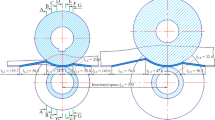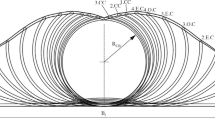Abstract
Physical and computer modeling of continuous shaping is described. In the experiments, strip workpieces undergo continuous shaping on a TESA 10-50 pipe-electrowelding system for pipe of diameter 50 mm with wall thickness 1 mm. The pipe blanks are shaped in horizontal and vertical shaping stands, with estimation of the geometric parameters. Single-radius grooves are used on the rollers. The forces affecting the geometry of the pipe blank are determined. Analysis of the workpiece geometry reveals defects of corrugation type on its right edge between the second edging stand and the third shaping stand. A similar defect appears on the left edge in the section between the third shaping stand and third edging stand. To eliminate defects in the shaping section, the horizontal stands are adjusted so that the forces at the drives are the same. Then the relevant forces are again determined: the tractional forces of the drives; the resistance to strip motion in the stands; and the vertical shaping forces. In calculating the forces, the basic parameters are determined by two methods. In the first, the geometric parameters of the pipe blank and the parameters in the bending section are taken into account, with allowance for deformation outside of the contact zone. In the second, the contact interaction of the pipe blank and the shaping tool over the deformation cross section is taken into account. The discrepancy between the calculation results and the experimental data is 8–12%. After correcting the shaping parameters and adjusting the roller grooving, defect-free pipe blanks are shaped. According to comparison of the calculated and experimental trajectories of the edges of the workpiece over the height and width in the stands, the discrepancy is 6–9%. In investigating the geometric parameters of the deformation region, the bending zones with and without contact are taken into account, as well as the springback section. The shaping parameters of the pipe blank are calculated in uniform and roller shaping zones. Analysis of the results shows that shaping of the workpiece corresponds to the assumptions regarding the change in its geometry in roller grooves.








Similar content being viewed by others
REFERENCES
Rymov, V.A., Polukhin, P.I., and Potapov, I.N., Sovershenstvovanie proizvodstva svarnykh trub (Improving the Production of Welded Pipes), Moscow: Metallurgiya, 1983.
Matveev, Yu.M. and Vatkin, Ya.L., Kalibrovka instrumenta trubnykh stanov (Alignment of Tool for Pipe Mills), Moscow: Metallurgiya, 1970.
Zhukovskii, B.D., Zil’bershtein, L.I., and Furmanov, V.B., Proizvodstvo trub (Pipe Production), Moscow: Metallurgiya, 1970.
Samusev, S.V., Zhigulev, G.P., Fadeev, V.A., and Manakhov, K.S., Shaping of pipe blanks on specialized bending equipment, Steel Transl., 2016, vol. 46, no. 3, pp. 169–172.
Samusev, S.V., Aleshchenko, A.S., and Fadeev, V.A., Simulation of the process of continuous forming of straight-seam welded pipes on the basis of Tesa 10-50 trainer, Izv. Vyssh. Uchebn. Zaved., Chern. Metall., 2018, vol. 61, no. 5, pp. 378–384.
Samusev, S.V., Aleshchenko, A.S., and Fadeev, V.A., Improving production technology of thin-walled pipes and shells of small diameter, Izv. Vyssh. Uchebn. Zaved., Chern. Metall., 2007, no. 7, pp. 36–38.
Walker, T.R. and Pick, R.J., Developments in the geometric modeling of an ERW pipe skelp, J. Mater. Process. Technol., 1991, vol. 25, no. 1, pp. 35–54.
Yusupov, V.S., Kolobov, A.V., Akopyan, K.E., Seleznev, M.S., and Sominin, M.A., Improving the production of electrowelded straight-seam pipe. Part 1, Steel Transl., 2015, vol. 45, no. 8, pp. 598–604.
Sun, B.-F. and Jin, Y.-H., Simulation analysis of shaping process of high frequency longitudinal electric resistance welded pipe, J. China Univ. Petrol., 2010, vol. 34, no. 4, pp. 123–126.
Kasaei, M.M., Naeini, H.M., Tafti, R.A., and Tehrani, M.S., Prediction of maximum initial strip width in the cage roll forming process of ERW pipes using edge buckling criterion, J. Mater. Process. Technol., 2014, vol. 214, no. 2, pp. 190–199.
Han, Z.-W., Liu, C., Lu, W.-P., et al., Experimental investigation and theoretical analysis of roll forming of electrical resistance welded pipes, J. Mater. Process. Technol., 2004, vol. 145, no. 3, pp. 311–316.
Danchenko, V.N., Kolikov, A.P., Romantsev, B.A., et al., Tekhnologii trubnogo proizvodstva (Pipe Production Technologies), Moscow: Intermet Inzhiniring, 2002.
Kolikov, A.P., Romanenko, V.P., Sheikh-Ali, A.D. et al., Mashiny i agregaty trubnogo proizvodstva (Machines and Units for Pipe Production), Moscow: Mosk. Inst. Stali Splavov, 1998.
Barabantsev, G.E., Tyulyapin, A.N., Kolobov, A.V., and Yusupov, V.S., Improvement of production of electric welded longitudinal pipes, Proizvod. Prokata, 2005, no. 5, pp. 21–23.
Li, J.-X., Xie, L.-Y., Wang, J.-J., and Xiong, J.-H., Numerical study of the forming process of high frequency welded pipe, J. Shanghai Jiaotong Univ., 2010, vol. 15, no. 2, pp. 236–240.
Abeyrathna, B., Rolfe, B., and Weiss, M., The effect of process and geometric parameters on longitudinal edge strain and product defects in cold roll forming, Int. J. Adv. Manuf. Technol., 2017, vol. 92, nos. 1–4, pp. 1–12.
Abeyrathna, B., Rolfe, B., Hodgson, P., and Weiss, M., Local deformation in roll forming, Int. J. Adv. Manuf. Technol., 2017, vol. 88, nos. 9–12, pp. 2405–2415.
Iguchi, K., Kuriyama, Y., Moroi, et al., Deformation behavior of high strength steel sheet during roll forming of electric resistance welded pipe, Steel Res. Int., 2012, special issue, pp. 927–930.
Paralikas, J., Salonitis, K., and Chryssolouris, G., Energy efficiency of cold roll forming process, Int. J. Adv. Manuf. Technol., 2013, vol. 66, nos. 9–12, pp. 1271–1284.
Panton, S.M., Zhu, S.D., and Duncan, J.L., Geometric constraints on the forming path in roll forming channel sections, Proc. Inst. Mech. Eng., Part B, 1992, vol. 206, no. 2, pp. 113–118.
Liu, C., Han, Z., Zhang, L., and Lu, W., Numerical modeling of the roll forming process of channel steel, Chin. J. Mech. Eng., 1999, vol. 12, no. 3, pp. 173–177.
Author information
Authors and Affiliations
Corresponding authors
Additional information
Translated by Bernard Gilbert
About this article
Cite this article
Samusev, S.V., Fadeev, V.A. Continuous Shaping of Welded Straight-Seam Pipe in the Open Stands of a Pipe-Welding System. Steel Transl. 49, 447–453 (2019). https://doi.org/10.3103/S0967091219070118
Received:
Revised:
Accepted:
Published:
Issue Date:
DOI: https://doi.org/10.3103/S0967091219070118




